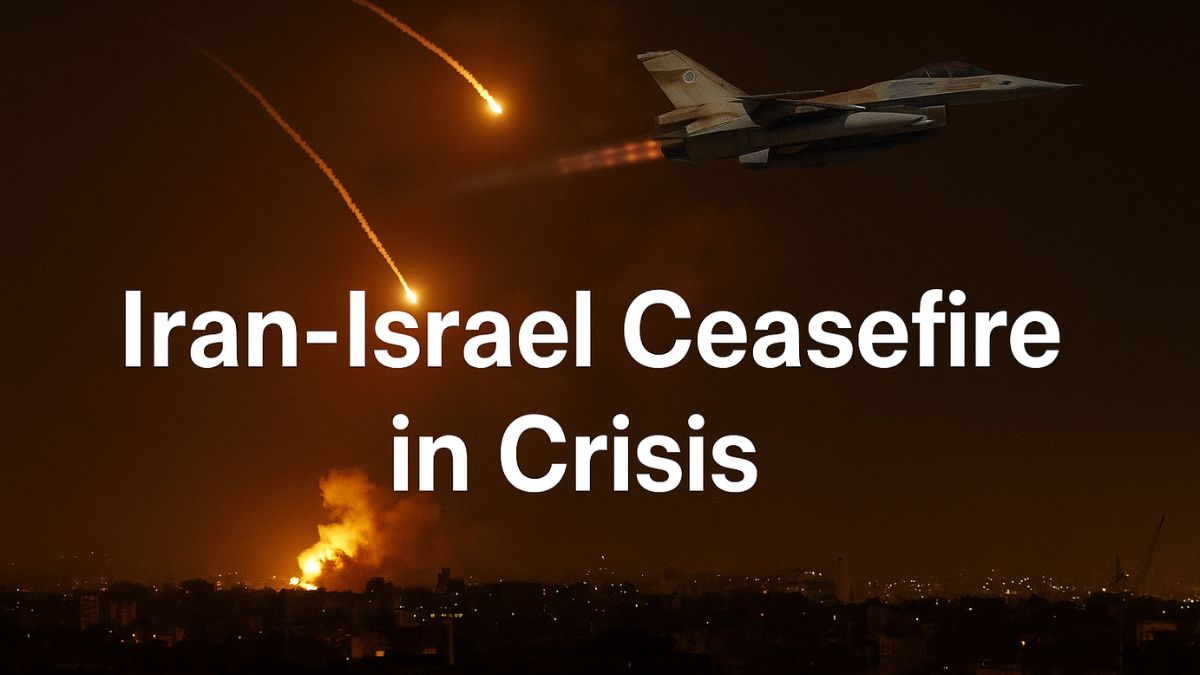New York: A much-anticipated ceasefire between Israel and Iran, brokered by U.S. President Donald Trump on June 23, appears to be collapsing within hours of its announcement. The agreement, hailed as a diplomatic breakthrough after nearly two weeks of escalating military conflict, was intended to halt hostilities that included missile exchanges, nuclear site strikes, and growing regional instability. But just a few hours into the truce, both sides are accusing each other of violating the terms.
According to Israeli officials, Iran fired two ballistic missiles toward northern Israel shortly after the ceasefire took effect. The Israeli Defense Forces (IDF) intercepted both missiles and responded swiftly with targeted airstrikes on radar installations near Tehran. In response, Iranian state media strongly denied the missile launch, calling Israel’s actions a breach of the ceasefire.
President Trump, who had personally announced and celebrated the ceasefire, reacted with visible frustration. Reports suggest that he even ordered Israeli warplanes to abort a mission mid-air and return to base, citing a serious violation of the agreement. While Trump condemned actions on both sides, he emphasized that Israel’s immediate post-truce strike was particularly disappointing. Now, with tensions again on the rise, the future of the fragile peace appears uncertain.
Also Read: Iran Fires Missiles at U.S. Base in Qatar — Flights Suspended, Tensions Rise
Timeline of the Ceasefire: What Happened and When
- June 23, 2025: President Trump announces a “complete and total ceasefire” between Israel and Iran following 12 days of escalating conflict.
- June 24, 2025 (Morning): Israel accuses Iran of launching two ballistic missiles, prompting retaliatory airstrikes.
- June 24, 2025 (Afternoon): Iran denies the missile launch and accuses Israel of breaking the ceasefire first.
- Trump’s Response: Trump condemns both nations and reportedly orders Israeli aircraft to turn back mid-flight.
Israel’s Claim: Iran Fired First
Israeli officials maintain that Iran breached the ceasefire less than three hours after it went into effect. According to the IDF, two Iranian ballistic missiles were launched toward northern Israel and intercepted before causing any damage. Israeli Defense Minister Israel Katz stated that the country had no choice but to respond with precision airstrikes to neutralize “future threats.”
The airstrikes, according to Israeli sources, were limited in scope and targeted only military infrastructure. However, the move has drawn criticism for escalating the situation further instead of allowing for independent verification of the alleged Iranian attack.
Also Read: Why Al Udeid Base Is So Important to the U.S. — And Why Iran Chose to Strike It
Iran’s Denial: “False Allegations”
Iranian officials have categorically denied launching any missiles after the ceasefire began. In statements released through state media ISNA and Press TV, Tehran accused Israel of using fabricated claims as a pretext for aggression. The Iranian Foreign Ministry announced it would file a formal complaint with the United Nations, asserting that Israel’s actions violate international law and the spirit of the ceasefire agreement.
Government spokespersons in Tehran urged the U.S. to hold its ally accountable, warning that failure to do so would undermine any future peace efforts in the region.
President Trump’s Reaction: From Celebration to Condemnation
When President Trump announced the ceasefire, he called it a “major win for peace and stability in the Middle East.” Just hours later, however, his tone shifted dramatically. Speaking at a press briefing from the White House, Trump condemned both Israel and Iran for “playing with fire.”
According to administration sources quoted by Fox News and Reuters, Trump was especially displeased with Israel’s immediate response and took the rare step of ordering a halt to a planned air mission. “This is not what peace looks like,” he was quoted saying. “This was supposed to be a reset—not a license to retaliate.”
Global Reactions: Fragile Hope and Growing Pressure
The international community responded swiftly. NATO, the United Nations, and key U.S. allies in Europe praised the ceasefire but urged restraint. French President Emmanuel Macron and UK Prime Minister Rishi Sunak emphasized the need for accountability and proposed sending neutral observers to monitor the situation.
Humanitarian agencies also raised alarms. With aid corridors still closed and violence threatening to resume, organizations like the Red Crescent and Doctors Without Borders warned of worsening civilian casualties in Gaza and central Iran.
What Happens Now?
Although the ceasefire remains technically in effect, analysts believe it may not survive unless immediate diplomatic steps are taken. The U.S. State Department confirmed ongoing talks with Qatari and Turkish intermediaries to salvage the agreement.
For now, the Middle East sits on a knife’s edge—caught between a truce that’s already fraying and the risk of renewed all-out conflict.







